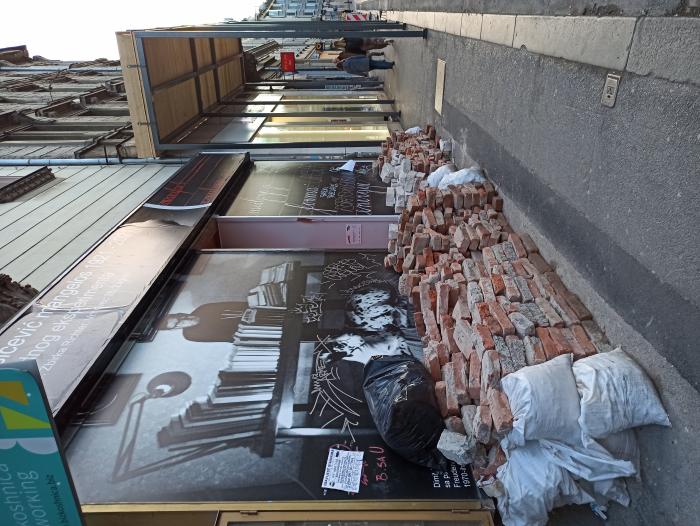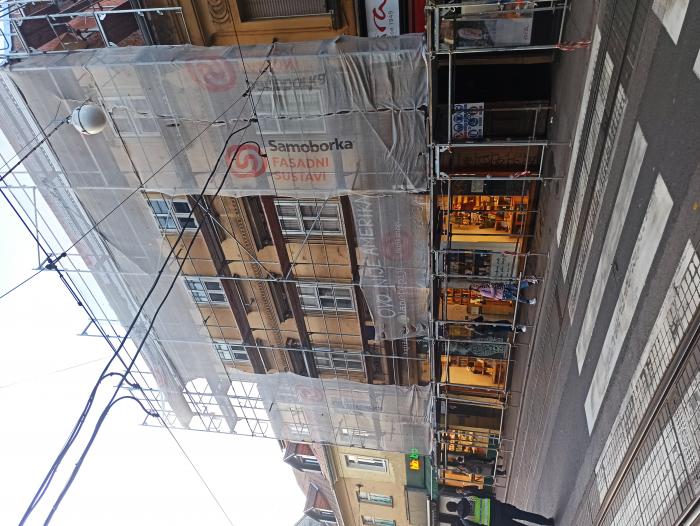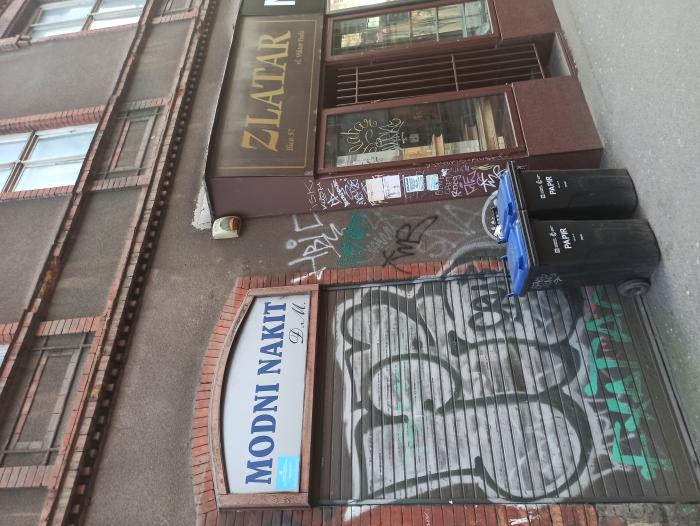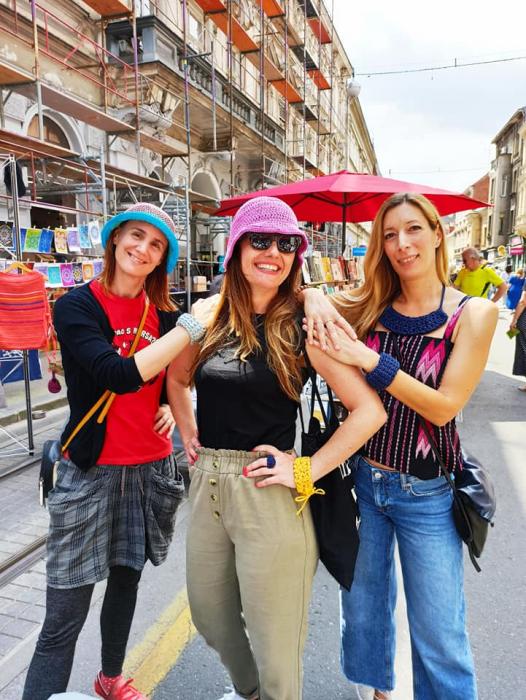Creativity is the engine to many social, economic and structural changes. The project aims to revitalize our city center, remaking it into a welcoming place pulsing with the power of creativity and enticing the development of new ideas and incentives.
Traditional skills and handmaking will be used as generators of urban and community development in providing the city with a social, cultural and artistic platform, open to all citizens, based on the values of green growth and social inclusion.
The aim of the project is to build a creative community, revitalizing the once urban and vivid area of central Zagreb, by establishing a physical space where artisans will exhibit their products and where events and workshops will be organized for everyone to create, learn and explore. Before our circumstances allow otherwise, this place will be operative for two to three days a week during which local artisans will use the exhibition space to showcase their work, and other members can use the specially intended spaces for holding workshops.
Regeneration of an urban area, the city center of Zagreb, and building a resilient local community is in the focus of this concept. The central streets of Zagreb today are full of empty and closed shops, disrupting the appearance and affecting the general vibe and atmosphere of the city. With the growth of mass production and shopping malls, the city center is left with less and less cultural and social content, and disintegration of local communities is additionally enhanced by general apathy and everyday rush.
Parallel to this, the project is hoping to create an association of artisans and sole proprietors, working outside of the economic mainstream, which transcends the boundaries of the physical space we are aiming to establish. This concept itself grew from a spontaneous recent unification of the artisan community, which is related to the tradition of Zagreb. Zagreb has a long history of artisan culture, dating from the 13th century. The development of crafts and their guilds greatly enhanced urban development. Despite their cultural significance and the possible community benefits, no similar organization exists today.
The project fully incorporates all three core values by connecting local heritage and traditions and turning them into a dynamo of sustainable development for present and future, while offering the local community a place that benefits their mental health, their personal growth and development.
Please highlight how the concept/idea can be exemplary in this context
The CURE project is in line with the 11th and the 12th UN global goal, “Sustainable cities and communities” and “Responsible production and consumption”, and local artisans and producers are its focus, being provided with a platform for direct contact with citizens as well as for networking and cooperation with each other. The artisans included are conscious and are actively raising awareness on the sustainable business models and circularity, including care for the raw material and its origin, practices of recycling, upcycling, and reusing. Moreover, an educational ethical codex is in the process of being written, meant to serve as a program and a guide for the type of production we wish to encourage, for current and future members of our project. Educations for the local community on these practices will be part of the activities implemented regularly. Workshops and lectures on how to apply sustainable practices in everyday life for citizens will be organized, just like educations on supraindividual trends with a negative impact on ecology, and awareness will be raised through promotional activities and social networks.
Environmental sustainability is ensured by our production processes and practices, materials, raising awareness of the value of handwork made by local artisans and creators, changing minds through positive examples of the opposite from the mass production and consumption, indicating benefits from shopping small and local, promoting recycling, reusing and upcycling, raising awareness on sustainable patterns of consumption and production, zero waste and circularity through explicit and practical examples.
Please highlight how the concept/idea can be exemplary in this context
As seen on the photos provided, the city center is more and more ruined because Zagreb is still heavily wounded by two earthquakes that took place in March and December of 2020. There are bricks on the streets and works on the buildings that are still being undertaken and the restoration is progressing extremely slowly. Watching this daily raises depression and effects the well-being of our citizens. Among 60 makers that have already stated their interest in participating in the project are designers, architects and artists who offer their skills to develop a concept and design the space that will have high aesthetic standards and will be attractive to the public, bringing beauty into everyday lives.
The project also aims to offer more valuable products, handmade and crafted by local artisans who are using traditional skills to create beautiful modern and useful products for citizens and their homes. Their products are unique, designed with care, displaying a wide variety of aesthetic qualities as well as uses in everyday life: clothes and accessories, home décor, toys, terrariums and plant walls, beauty and health products. The skills they are using are, to name just a few, metallurgy, embroidery, glass fusion, ceramics, woodwork, knitting and painting, each of them with a modern and unique twist.
An event which served as the impetus for the realization of this project and is the basis for our plan is the “Projekt Ilica Q’Art” manifestation, Zagreb festival during which the longest street of the city center is dominated by an extensive art fair, live music, exhibitions and performances. With thousands of visitors, the lively celebration is a true landmark of our city and the collaboration between the organizers of the festival and our initiative has already been established. In a similar fashion, we wish to offer a full aesthetic experience with striking visuals, music and performances to draw citizens in.
Please highlight how the concept/idea can be exemplary in this context
We are creating a cultural urban area in which the artisans are focused on sharing their knowledge and experience with the community, fully aware of the importance of craft as a therapy, as well as of its power to connect people. Engaging the local community in creative activities strengthens social connections. The project is creating a space for all, to participate in making their own designs and artefacts, to learn and grow, to find their own place in the community, and learn about the importance of creative activities for well-being – accessible and affordable to everyone.
The yard and the workshops are accessible and in accordance with article 9th of the UN Convention on the Rights of Persons with Disabilities. Moreover, our designers are aiming to project a universally accessible space. Advocacy of human rights is also an important part of our values as creators, and the concept will include different groups and support them through various activities (as part of Pride month, International Women’s day, and similar). The concept fosters equal opportunities, as it incorporates support and promotes the entrepreneurship of women and youth. It also tackles the 5th UN global goal, “Gender equality”, since most of the creators and makers who will participate are women (out of more than 60 members, artisans that showed interest in the concept so far, 58 are women). Also, many of them are young and just starting their businesses.
The project’s educational activities have 2 target groups: the first one, as described, is the entire local community, and the second one is the creators themselves – specifically youth and unemployed. For those interested in developing their own proprietorship, the project will offer an incubator, helping them develop their ideas and grasp the legal framework of business, just as offering them a platform to grow. Helping artisans strengthen their capacities and develop their ideas will contribute to their competitiveness and sustainability.
Please highlight how this approach can be exemplary
All three dimensions by their nature converge in the tradition of artisan guilds, from which this project takes its inspiration. Non-industrial production which artisans utilize is an exemplar of sustainability, and there is an inherent aesthetic value in unique, handmade products. In addition to that, artisans are committing an almost revolutionary act by taking artistic creativity from specialized, exclusive places, and putting it on the streets and in direct contact with the general public. Cities are transformed by culture and art, and creativity is the engine to many social and economic changes.
An association of local artisans is already growing and thriving, but mostly on social networks. There is a great need of transforming this digital association and giving it a space for direct communication with the public and for sharing its art and practices. This new community is eager to share their art through workshops, lectures and demonstrations of their processes and materials. Local artisans are using traditional skills in a sustainable manner, from sustainable resources. This process is inclusive because the citizens are invited in to participate in workshops, to monitor the process, to learn about raw materials and how they are transformed into unique pieces. Regular thematic events tackling various crafts, sustainable practices that transform and improve citizens’ lives, and are also therapeutic, will be organized. Sharing the joy and beauty of creating with your own hands will transform abandoned and devastated spaces into a home of creativity.
The project will promote the entrepreneurship of mostly women and youth, through its incubator of transparent and green business models responsible towards the citizens who they are creating for. Exhibitions, workshops, expert guests from relevant fields and CSOs will add value to creating a place of inspiration and development of new ideas, ensuring the inclusion and participation of all members of society.
No similar place exists in Croatia. There is a big number of makers active on social networks and an analysis has been made through a questionnaire answered by more than 60 so far. Many of them already offered to support the project with their knowledge in marketing, social media, business growth and similar. Every member has a set of skills that can help the others and there is a great need of a platform that would make this possible. Even in the time of growing digitalisation and perhaps especially because of the pandemic, there is a great need for the transfer of communication from the virtual to face-to-face human interaction. Handmaking workshops are something impracticable online. A location where artisans can gather and offer their local community a place to join them and create, develop their talents and learn about sustainable practices in everyday life doesn’t exist.
The project is strengthening resilience of the local community in an innovative way, learning by doing and by simultaneously building a strong, supportive community. The guilds that were formed in the history were established mainly for economic growth and to protect the interest of artisans. This new community of artisans is turned to the needs of the local community as well. People are showing more and more interest in creativity, on one side because of the organic human need to express oneself but also, in many cases, as a form of therapy that surfaced as an elementary need in the times of pandemic.
Our project also represents an incubator and multiplication ground for new innovative ideas. Friendly, non-profit environments in which anyone is encouraged to develop and start their sustainable business don’t exist in Croatia and are still a rare occurrence in the entire world. Common interests connect people and form new social circles, ideas and communities then grow from it, leading to new solutions for everyday problems. Creativity develops critical thinking and new solutions arise.
The founding assembly of our CSO called “Artizanat”, where all the interested artisans are becoming members with the right to use our space according to a monthly schedule, was convened and voted on the organization statute on February 23. The location for the activities has also been found – it is situated in a yard of the Ilica, the longest street in Zagreb, that was once full of artisans and that is close to the main square. Arranging and equipping the space is a priority for the activities to start.
A website and profiles on social networks will be created next, since it is important to offer regular information on activities, mission and vision of the project, rights and obligations of members, as well as to have a platform for promotional activities. Proceeding from this, activities with the aim of supporting proprietors and especially young people who wish to start their business will begin.
Creating and coordinating events that will be attractive to the local community and promoting them constitutes an important part of the project. The biggest part is the education and awareness-raising about the importance and the value of mindful production and the supply chain, and about the heritage of traditional skills and how they can be used in the everyday life.
60 artisans are interested to participate and share their knowledge in various domains of making this project a reality. They have already offered their competences. The location which will be used includes an interior space as well as a big yard so the concept will include an exhibition area, workshop area and a networking and community area.
Finally, the project would aim to obtain the rights to use a larger and a more secure space through a local government program which gives away abandoned public buildings to be used for socially conscious purposes, to expand its scope in the coming years.
Activities during the first year can be divided in 2 strands. The 1st one is strengthening the capacities of artisans and the 2nd one is raising public awareness and community-building.
Programs for the 1st one are comprised of education on sustainable business models and empowering women and youth to start and develop their businesses. There is a common understanding that community grows stronger with mutual support and assistance. In the case of winning the prize, our organization could offer more concrete help to young artisans just starting their business by being able to afford easier access to necessary tools, software and gear proprietors need when starting a business.
Activities for the 2nd one are comprised of promotion and education for the general public: producing media content for social networks and preparing material for media, with videos and stories on how the objects are made and what are the benefits of crafts for individuals and society in general, organizing workshops, exhibitions and similar events for the public, and promoting awareness on sustainable patterns of consumption and production. These promotional activities will also greatly add to the business growth of the artisans participating, and artisans in general. Greater financial security makes it possible to invest in reaching a far greater audience through media.
If a permanent town space could be secured within the following year, the funds from the prize would be of immense help in setting it up since most of the buildings in the program, being abandoned, have faulty or broken appliances and require a significant amount of investment to be brought to the aesthetic level we strive towards.
Since we have already managed to generate an interest even among artisans from different cities, more funds and faster development would enable us to sooner be able to form partnerships, organize events in other places and even stimulate similar projects in different cities and countries.
@Mršić, 2022
Content licensed to the European Union.





